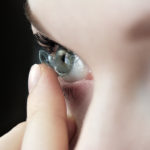By Melissa Barnett, OD, FAAO, FSLS, FBCLA

August 19, 2020
During the pandemic, patients may want to wear contact lenses more than ever since face masks fog up glasses. There also is the advantage over glasses of improved peripheral vision with contact lenses. You can still safely fit patients in contacts, if you take the proper precautions in your practice, and take the time to educate patients about hygienic lens handling and cleaning.
During these unprecedented times of the COVID-19 pandemic, we have been propelled to evaluate best practices for contact lens fitting. It is important to develop practices and procedures in your practice to ensure safety at all times.
Are CLs Still Safe to Wear?
There has been speculation to the contrary, but according to the latest available scientific evidence, contact lenses are safe to wear during a pandemic. According to the Center for Disease Control and Prevention, the American Academy of Optometry and the American Optometric Association, there is no evidence to suggest that contact lens wearers are more at risk for acquiring COVID-19 than those who wear glasses.
All patients who are fit with contact lenses and are welcome in our practice are screened and have temperature checks prior to the examination to ensure extra safety.
CLs During COVID Educational Resources
Also from AOA: Contact Lens Wear During COVID-19
Guidelines of Multipatient Contact Lenses in the Clinical Setting
American Academy of Optometry: COVID-19 Update
Centre for Ocular Research & Education: COVID-19 and contact lenses: the facts you need to know
Click HERE to learn more about the Federal Trade Commission’s recent action on the Contact Lens Rule that requires a signed acknowledgment form for contact lens prescriptions.
Daily Disposable CLs are Safest
Daily disposable lenses offer a clean, healthy lens each day which reduces the risk of debris and bacteria build up on lenses. Also, cleaning solutions and contact lens cases are not needed, which may lessen the risk of infection. It is of upmost importance to replace daily disposable lenses every single day to reduce the risk of infection.
The large post-market surveillance Tempo registry evaluated rates of adverse events with hydrogel and silicone hydrogel daily disposable lenses and found that corneal infiltrative events (CIEs) with daily disposable lenses were rare. The rates of CIEs with silicon hydrogel lenses was 0.4 percent per year and zero with hydrogel lenses. Rates of CIEs were significantly lower than rates with reusable soft contact lenses (3-4 percent per year). Stated differently, reusable contact lenses with solutions had a 12.5 x increased risk of CIE compared to daily disposable lenses. Thus, there are improved safety outcomes with daily disposable lenses.1
Patient Education Is More Important than Ever
In our practice, we are prescribing contact lenses for new patients. New patients can be safely taught how to care and handle contact lenses, even in a pandemic. For those who require medically necessary contact lenses, it is also safe to fit and prescribe contact lenses during the pandemic.
Contact lenses are safe and healthy to wear with the right precautions. Continuous education of proper hygiene and healthy contact lens wear are always important. However, these are especially important during the pandemic.
Good hygiene habits are critical. Wash hands for 20 seconds with soap and water and dry with a clean paper towel prior to applying and removing contact lenses.
Other Articles to Explore
Proper wear and care of contact lenses is critical. If daily disposable contact lenses are worn, replace lenses after each wear. Instruct patients that if reusable lenses are worn, clean and disinfect lenses according to their doctor’s recommendation. Also, advise them not to top-off or reuse solution.
Instruct patients that they should temporarily stop wearing contacts and wear glasses instead if they contract any illness, including COVID-19. Once healthy, and have confirmed that contacts are safe to wear with their eye doctor, contact lens wear may be resumed. Patients should understand the importance of using new contact lenses and a new contact lens case after an illness.
Patients should also be advised during this time to avoid extended wear, or sleeping in, their contact lenses. There is a low incidence of microbial keratitis or symptomatic inflammatory keratitis with strict daily wear of contact lenses.2
According to the World Health Organization (WHO) and U.S. Centers for Disease Control and Prevention (CDC) recommendations, patients should avoid touching mucous membranes such as the nose, mouth and eyes with unwashed hands. Both spectacle and contact lens wearers should be advised to avoid touching mucous membranes.
Can I Still Safely Fit CLs?
It is safe to fit contact lenses with proper personal protective equipment (PPE). Everyone including staff and patients should be required to wear masks. If the patient presents without a mask, or an inappropriate mask, the office must provide a mask. Disinfect hands with alcohol and /or wear surgical gloves prior to handling contact lenses. If wearing gloves, confirm that gloves are well fitting and change gloves after every patient and disinfect hands. It is safe to place a contact lens on a patient’s eye with proper hand hygiene and PPE in place.
Contact lens trainings in our office now have a large plastic barrier to separate the contact lens technician and patient. Videos may be used to teach contact lens insertion and removal prior to an in-office appointment to reinforce the technique while reducing in-person time.
Can I Safely Use Diagnostic Lenses?
The use of diagnostic, or trial, contact lenses is customary is clinical practice. These lenses must be disinfected prior to storage and use on another patient. Especially during the pandemic, contact lens practitioners face the threat of transferring potential pathogens from one patient to another when reusing diagnostic contact lenses on multiple patients in practice.
Contact lenses may be fit empirically to avoid the use of diagnostic lenses. If diagnostic lenses are used, it is important to adhere to the Guidelines for Handling of Multi-Patient Contact Lenses in the Clinical Setting3 which includes protocols for disinfection and a log for each lens fitting set. If a patient has a confirmed infection such as COVID-19, the diagnostic contact lens must be discarded.
Patients who already wear contact lenses come to our office wearing their lenses for at least four hours, if possible, to evaluate lenses. Patients remove lenses themselves if they are existing wearers to evaluate the ocular surface. This protocol has not changed since the pandemic.
Exercise Extra Caution When Treating A Red Eye or Conjunctivitis
Any red eye or conjunctivitis needs to be taken seriously during the pandemic. If a patient presents with a red eye that is suspected for COVID-19, full PPE including goggles, N-95 mask, gloves and gown are worn prior to examining the patient.
The frequency of conjunctivitis in COVID-19 patients is rare and is reported to date 1-5 percent, but caution is advised when examining these patients.
Conjunctivitis differentials include bacterial, viral due to another virus such as herpetic and allergic. To differentiate a contact lens related red eye to a COVID-related red eye, it is pertinent to ask about systemic symptoms such as fever or chills, cough, shortness of breath or difficulty breathing, fatigue, muscle or body aches, headache, new loss of taste or smell, sore throat, congestion or runny nose, nausea or vomiting or diarrhea.
Inquiring about contact lens hygiene practices, including extended wear, contact lens wearing time and replacement, solutions and case hygiene is of upmost importance, especially during this health crisis.4
 Melissa Barnett, OD, FAAO, FSLS, FBCLA, is principal optometrist at University of California, Davis Eye Center. To contact her: drbarnett@ucdavis.edu
Melissa Barnett, OD, FAAO, FSLS, FBCLA, is principal optometrist at University of California, Davis Eye Center. To contact her: drbarnett@ucdavis.edu
References
1. Chalmers RL1, Hickson-Curran SB2, Keay L3, et al. Rates of adverse events with hydrogel and silicone hydrogel daily disposable lenses in a large postmarket surveillance registry: the TEMPO Registry. Invest Ophthalmol Vis Sci. 2015 Jan 8;56(1):654-63. doi: 10.1167/iovs.14-15582.
2. Becmeur PH, Abry F, Bourcier T, Meyer N, Sauer A; « the French Study Group for Contact Lens-Related Microbial Keratitis ». Facteurs de risque de kératites infectieuses chez les porteurs de lentilles de contact, une étude cas-témoins [Risk factors for contact lens-related microbial keratitis: A multicenter case-control study]. J Fr Ophtalmol. 2017;40(3):224-231. doi:10.1016/j.jfo.2016.10.008
3. Sindt C, Bennett E, Szczotka-Flynn L, Sclafani L, Barnett M; American Academy of Optometry (AAO) Section on Cornea, Contact Lenses & Refractive Technologies, and The American Optometric Association (AOA) Contact Lens and Cornea Section. Technical Report: Guidelines for Handling of Multipatient Contact Lenses in the Clinical Setting [published online ahead of print, 2020 Aug 6]. Optom Vis Sci. 2020;10.1097/OPX.0000000000001547. doi:10.1097/OPX.0000000000001547
4. Reference 1 Xia J., Tong J., Liu M., Shen Y., Guo D. Evaluation of coronavirus in tears and conjunctival secretions of patients with SARS-CoV-2 infection. J Med Virol In press. 2020; reference 2 Guan W.J., Ni Z.Y., Hu Y., et al. China Medical Treatment Expert Group for, Clinical Characteristics of Coronavirus Disease 2019 in China. N Engl J Med In press. 2020

























